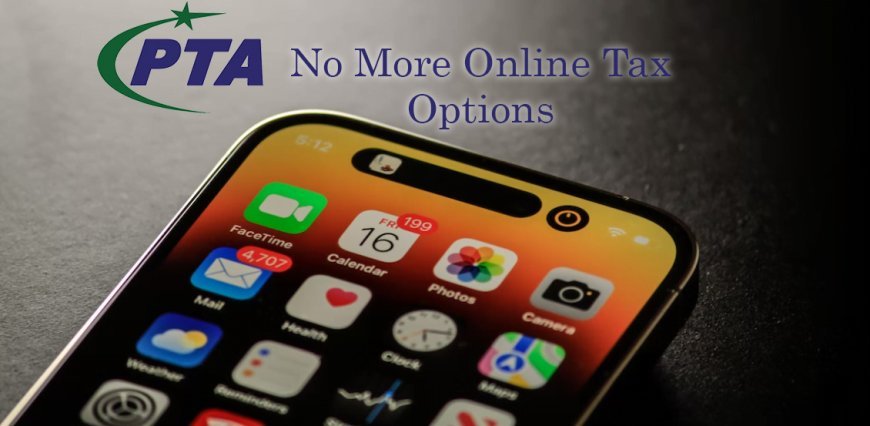PTA Removes Online Payment Option for Mobile Phone Taxes, Introduces Offline Procedure
The article discusses the removal of online payment for PTA taxes on mobile phones in Pakistan, highlighting the implications and suggesting potential solutions.

In a recent development, the Pakistan Telecommunication Authority (PTA) has taken the decision to remove the facility for online payment of PTA taxes on mobile phones. This move surprises many, as online payment methods such as online banking, Easy Paisa by Telenor, and Jazz Cash by Mobilink were widely used by mobile phone users to pay their taxes conveniently.
Now, individuals must generate a Payment Slip Identification (PSID) from the PTA's online portal and download the invoice, which must be presented at the nearest bank for tax fee payment. This article explores the implications of this decision. It sheds light on the PTA's role in collecting taxes on mobile phones in Pakistan.
Understanding PTA and Mobile Phone Taxes
The Pakistan Telecommunication Authority (PTA) is the regulatory body responsible for the administration and oversight of the telecommunications sector in Pakistan. Apart from its regulatory role, the PTA also plays a crucial part in collecting taxes on mobile phones, commonly referred to as PTA taxes.
PTA taxes on mobile phones were introduced in 2018 as part of the Device Identification, Registration, and Blocking System (DIRBS) initiative. The primary objective of DIRBS is to curb the smuggling and illegal use of mobile devices by implementing a transparent and traceable system. Under this system, mobile devices must be registered with the PTA, and taxes are levied on imported and domestically purchased phones.
Online Payment Facility Removal and Its Implications
The decision to remove the online payment facility for PTA taxes on mobile phones has raised concerns among mobile phone users across Pakistan. Previously, online banking platforms and mobile wallet services such as Easy Paisa and Jazz Cash provided a convenient way for individuals to pay their taxes from the comfort of their homes or offices. This facilitated prompt tax payments and reduced the hassle of visiting physical locations.
The new offline procedure requires individuals to generate a PSID from the PTA's online portal (https://dirbs.pta.gov.pk/drs) by providing relevant information about the device and the owner. Once the PSID is generated, users are required to download the invoice and physically visit the nearest bank to make the tax payment. While this process may seem straightforward, it poses certain challenges and inconveniences for taxpayers.
Firstly, removing the online payment option eliminates convenience, forcing individuals to take time out of their busy schedules to visit a bank branch. This not only adds a burden but also disrupts their daily routine. Moreover, it may lead to longer queues and increased waiting times at the banks, affecting the taxpayers' and operational efficiency.
Secondly, the online payment facility offered a secure and reliable channel for individuals to make their tax payments. By removing this option, there may be concerns regarding the security of personal and financial information shared during the offline payment. The PTA and relevant authorities must ensure the necessary safeguards are in place to protect taxpayers' data and prevent unauthorized access or misuse.
Additionally, the sudden removal of the online payment option may create confusion among mobile phone users who were accustomed to the previous method. It is essential for the PTA to proactively communicate this change through multiple channels, including official announcements, public awareness campaigns, and instructions on the PTA's online portal. Clear guidelines and step-by-step instructions should be provided to assist taxpayers in navigating the new offline payment process smoothly.
The Way Forward
While removing the online payment option may be perceived as a step backward regarding convenience and ease of payment, it is crucial to understand the rationale behind the PTA's decision. The authorities may have identified certain challenges or limitations in the previous system, leading to the introduction of the new offline payment procedure. However, the PTA must address the concerns of taxpayers and ensure that the new process is user-friendly and efficient.
To mitigate the inconvenience caused by this change, the PTA should explore alternative payment options that offer similar convenience and security as the previous online methods. Collaborating with financial technology companies and mobile network operators can provide innovative solutions like mobile wallet integration or payment through specialized apps. This would streamline the tax payment process and align with the country's growing digital transformation.
Moreover, the PTA should invest in improving the efficiency and effectiveness of its online portal. This includes enhancing the user interface, minimizing technical glitches, and ensuring seamless integration with relevant banking systems. By prioritizing user experience and incorporating user feedback, the PTA can create a more user-friendly platform that simplifies the tax payment process.
Conclusion
The removal of the online payment option for PTA taxes on mobile phones has generated mixed reactions among mobile phone users in Pakistan. While the decision may have been driven by the need to address certain challenges or limitations, the PTA must prioritize user convenience and security in the new offline payment procedure.
Clear communication, user-friendly guidelines, and proactive measures can minimize the inconvenience caused by this change and ensure a smooth transition for taxpayers. Additionally, the PTA should explore innovative solutions in collaboration with relevant stakeholders to reintroduce online payment options and leverage the benefits of digital transformation in tax collection processes.









